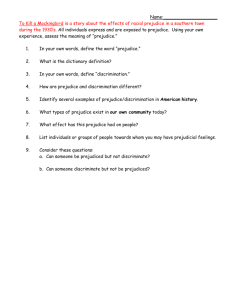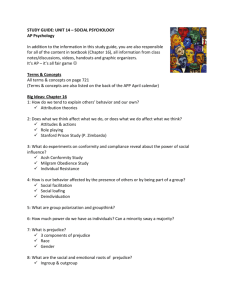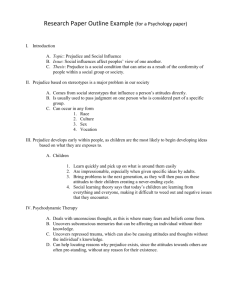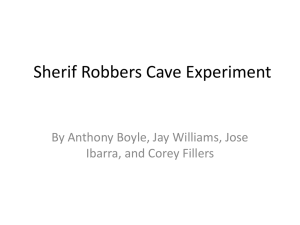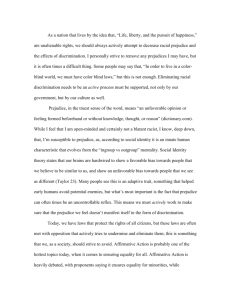RACIAL PREJUDICE AND DISCRIMINATION
advertisement
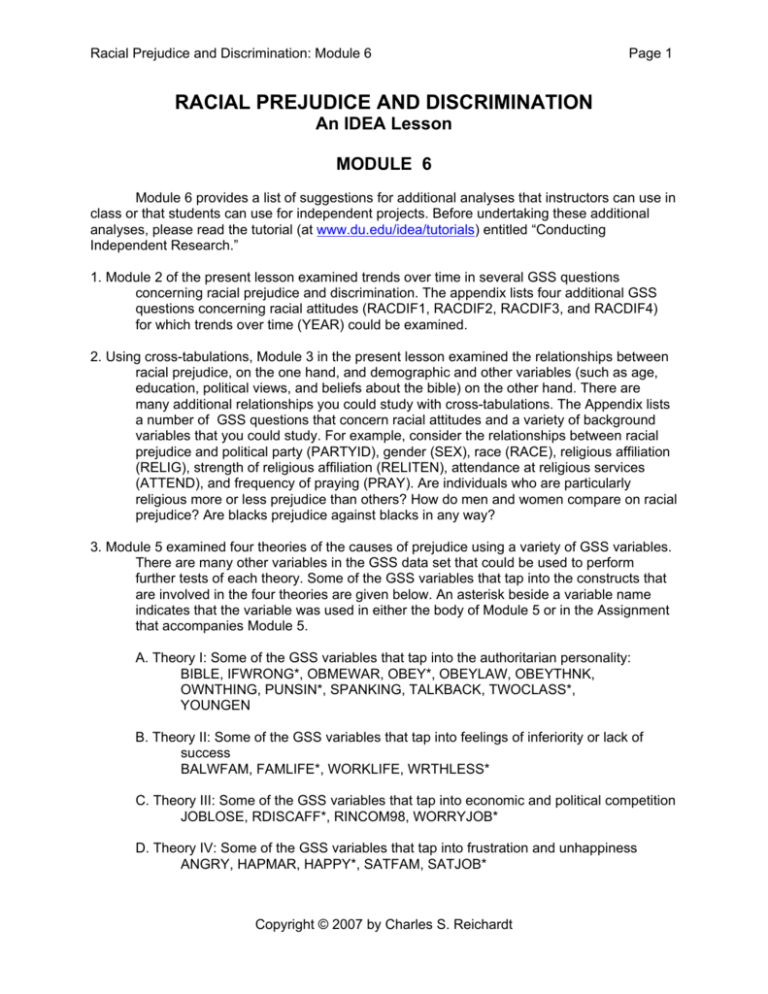
Racial Prejudice and Discrimination: Module 6 Page 1 RACIAL PREJUDICE AND DISCRIMINATION An IDEA Lesson MODULE 6 Module 6 provides a list of suggestions for additional analyses that instructors can use in class or that students can use for independent projects. Before undertaking these additional analyses, please read the tutorial (at www.du.edu/idea/tutorials) entitled “Conducting Independent Research.” 1. Module 2 of the present lesson examined trends over time in several GSS questions concerning racial prejudice and discrimination. The appendix lists four additional GSS questions concerning racial attitudes (RACDIF1, RACDIF2, RACDIF3, and RACDIF4) for which trends over time (YEAR) could be examined. 2. Using cross-tabulations, Module 3 in the present lesson examined the relationships between racial prejudice, on the one hand, and demographic and other variables (such as age, education, political views, and beliefs about the bible) on the other hand. There are many additional relationships you could study with cross-tabulations. The Appendix lists a number of GSS questions that concern racial attitudes and a variety of background variables that you could study. For example, consider the relationships between racial prejudice and political party (PARTYID), gender (SEX), race (RACE), religious affiliation (RELIG), strength of religious affiliation (RELITEN), attendance at religious services (ATTEND), and frequency of praying (PRAY). Are individuals who are particularly religious more or less prejudice than others? How do men and women compare on racial prejudice? Are blacks prejudice against blacks in any way? 3. Module 5 examined four theories of the causes of prejudice using a variety of GSS variables. There are many other variables in the GSS data set that could be used to perform further tests of each theory. Some of the GSS variables that tap into the constructs that are involved in the four theories are given below. An asterisk beside a variable name indicates that the variable was used in either the body of Module 5 or in the Assignment that accompanies Module 5. A. Theory I: Some of the GSS variables that tap into the authoritarian personality: BIBLE, IFWRONG*, OBMEWAR, OBEY*, OBEYLAW, OBEYTHNK, OWNTHING, PUNSIN*, SPANKING, TALKBACK, TWOCLASS*, YOUNGEN B. Theory II: Some of the GSS variables that tap into feelings of inferiority or lack of success BALWFAM, FAMLIFE*, WORKLIFE, WRTHLESS* C. Theory III: Some of the GSS variables that tap into economic and political competition JOBLOSE, RDISCAFF*, RINCOM98, WORRYJOB* D. Theory IV: Some of the GSS variables that tap into frustration and unhappiness ANGRY, HAPMAR, HAPPY*, SATFAM, SATJOB* Copyright © 2007 by Charles S. Reichardt Racial Prejudice and Discrimination: Module 6 Page 2 By creating cross-tabulations between the variables in the preceding lists and variables that reveal racial attitudes (i.e., RACMAR, RACOPEN, RACPUSH, RACSEG), you could perform further tests of the four theories of the causes of racial prejudice. Or perhaps you have your own theory of the causes of racial prejudice and you could find GSS questions to use to put your theory to the test. 4. The present lesson examines racial prejudice using the GSS questions such as RACMAR, RACOPEN, RACPUSH, and RACSEG. The GSS also asks questions about women and their perceived role in society: such as FEHOME, FEPOL, and FEPRES (which concern women’s role in politics) and FEFAM, FEHELP, and FEWORK (which concern women’s role in the work place). The GSS also asks a question (HOMOSEX) concerning attitudes about homosexuality. You could compare prejudice against blacks with prejudice against women or homosexuals. You could examine trends over time (YEAR) in the different types of prejudice (Module 2). You could also see if demographic and other background variables (such as AGE, RACE, SEX, DEGREE, POLVIEWS, and PARTYID) are related in the same fashion to questions about the three different types of prejudice (Module 3). Or you could see if the four theories of racial prejudice also apply to prejudice against women and homosexuals (Module 5). 5. The World Values Survey (WVS) is a data set, like the GSS, that can be analyzed on the web using the SDA interface. The WVS contains data from representative samples of almost 80 different nations. You can learn more about the WVS at www.du.edu/idea/director/about-wvs.htm. In the WVS, questions are denoted by numbers rather than names. Question number V52 concerns racial prejudice and has the following wording: V52 – Neighbors: Diff Race On this list are various groups of people. Could you please sort out any that you would not like to have as neighbors? Mentioned Not Mentioned People of a different race 1 2 There are also questions with much the same wording as question V52 that ask about prejudice against other types of people such as Muslims (V56), immigrants/foreign workers (V57), and homosexuals (V60). The variable labeled V2 denotes the different countries in the WVS. A crosstabulation created by entering V52 as the “Row” variable and V2 as the “Column” variable would give the responses to the V52 variable for all 80 nations. You could make a smaller table by restricting the number of nations. For example, if you enter V2(1, 2, 4, 8, 11, 13, 14, 19, 28, 29, 32, 39, 44, 50), you will get a table for responses from the following nations: 1 Britain 2 West Germany 4 Italy 8 Spain 11 United States 13 Japan 14 Mexico 19 Sweden 28 Brazil 29 Nigeria Copyright © 2007 by Charles S. Reichardt Racial Prejudice and Discrimination: Module 6 32 39 44 50 Page 3 India China Turkey Russia In addition, the variable labeled V214 denotes sex and the variable AGEGROUP groups ages into several categories. You could use the V52 question to compare racial prejudice across different nations. You could also compare racial prejudice to, say, prejudice against Muslims across different nations (or within select nations). Or you could see if gender and age have the same relationship to prejudice in different nations. 6. The GSS contains questions that ask respondents to rate: A. the general intelligence of different racial and ethnic groups (INTLASNS, INTLBLKS, INTLHSPS, INTLJEWS, INTLSO, and INWHTS) B. how hard working or lazy different racial and ethnic groups are (WORKASNS, WORKBLKS, WORKHSPS, WORKJEWS, WORKSO, and WORKWHTS) C. the degree to which different racial and ethnic groups are committed to fair and equal treatment of everyone (FAREASNS, FAREBLKS, FAREHSPS, FAREJEWS, FARESO, and FAREWHTS) Many of these items would best be examined by calculating means rather than creating cross-tabulations. You can learn how to use the SDA interface to calculate means by reading the tutorial entitled “Comparing Means” at the IDEA Project web site (www.du.edu/idea/tutorials). After reading this tutorial, you could compare mean levels of prejudice on the above listed questions across the different racial and ethnic groups. You could also see if correlates of prejudice (such as DEGREE, AGE, RACE, and so on) are the same for prejudices against different racial and ethnic groups using the listed questions in A, B, and C above. Copyright © 2007 by Charles S. Reichardt

